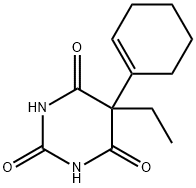CYCLOBARBITAL
- CAS No.
- 52-31-3
- Chemical Name:
- CYCLOBARBITAL
- Synonyms
- Adorm;Irifan;Amnosed;Cavonyl;Hexemal;Namuron;Palinum;Rapidal;Fanodorm;Hypnoval
- CBNumber:
- CB9491306
- Molecular Formula:
- C12H16N2O3
- Molecular Weight:
- 236.27
- MDL Number:
- MFCD00059173
- MOL File:
- 52-31-3.mol
| Melting point | 171-174° |
|---|---|
| Boiling point | 378.73°C (rough estimate) |
| Density | 1.1623 (rough estimate) |
| refractive index | 1.5460 (estimate) |
| solubility | Chloroform (Slightly), Ethanol (Slightly), Methanol (Slightly) |
| form | Solid |
| pka | 8.03±0.10(Predicted) |
| color | White to Off-White |
| Water Solubility | 8.27g/L(25 ºC) |
| EWG's Food Scores | 1 |
| FDA UNII | 0M8A98AD9H |
| ATC code | N05CA10 |
SAFETY
Risk and Safety Statements
| Symbol(GHS) |  GHS07 |
|---|---|
| Signal word | Warning |
| Hazard statements | H302 |
| Precautionary statements | P264-P270-P301+P312-P330-P501 |
| RIDADR | 3249 |
| HazardClass | 6.1(b) |
| PackingGroup | III |
| Toxicity | LD50 in mice, rats (mg/kg): 350, 290 i.p. (Hofrichter) |
CYCLOBARBITAL Chemical Properties,Uses,Production
Originator
Cyclobarbital,Bayer
Uses
Cyclobarbital has been used as an anesthetic and sedative. Controlled substance (depressant).
Definition
ChEBI: Cyclobarbital is a member of barbiturates.
Manufacturing Process
772.0 g of δ-1,2-cyclohexenylcyanacetic acid ethyl ester are introduced into astirred and ice cooled solution of 92.0 g of sodium in 1500 ml of absolutealcohol. The sodium δ-1,2-cyclohexenylcyanacetic acid ester formed is thengradually treated without ice cooling with 750.0 g of ethyl iodide. The reactionmixture become warm, sodium iodide separates out and the whole is neutralafter a short time. The sodium iodide is filtered off, the filtrate freed fromalcohol by distillation, the residues taken up in water, siphoned off, dried overcalcium chloride and distilled in vacuum, yields δ-1,2-cyclohexenylethylcyanacetic acid ethyl ester, boil point 125°C. 72.0 g ofsodium are dissolved in 1086.0 g of absolute alcohol and boiled for 3.75 hwith 285.0 g of guanidine sulfate, then 221.0 g of δ-1,2-cyclohexenylethylcyanacetic acid ester are added and boiling is continued for afurther 12 h. The residue remaining after distilling off the alcohol is boiledwith 10 times its weight of dilute sulfuric acid and then δ-1,2-cyclohexenylethylbarbituric acid which separates out is recrystallized from hotwater, melting point 170°C
brand name
Phanodorn (Sterling Winthrop).
Therapeutic Function
Hypnotic
Safety Profile
Poison by ingestion, subcutaneous, intravenous, and intraperitoneal routes. Human systemic effects by ingestion: pulmonary consolidation. Used as a central nervous system depressant, hypnotic, and sedative. When heated to decomposition it emits toxic fumes of NOx. See also BARBITURATES.





